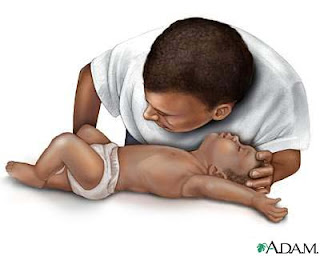How To Perform CPR On A Child And A Baby

To perform CPR on a baby
Most cardiac arrests in babies occur from lack of oxygen, such as from drowning or choking. If you know the baby has an airway obstruction, perform first aid for choking. If you don’t know why the baby isn’t breathing, perform CPR.
To begin, examine the situation. Stroke the baby and watch for a response, such as movement, but don’t shake the baby.
If there’s no response, follow the ABC procedures below and time the call for help as follows:
* If you’re the only rescuer and CPR is needed, do CPR for two minutes — about five cycles — before calling 911 or your local emergency number.
* If another person is available, have that person call for help immediately while you attend to the baby.
Airway: Clear the airway
1. Place the baby on his or her back on a firm, flat surface, such as a table. The floor or ground also will do.
2. Gently tip the head back by lifting the chin with one hand and pushing down on the forehead with the other hand.
3. In no more than 10 seconds, put your ear near the baby’s mouth and check for breathing: Look for chest motion, listen for breath sounds, and feel for breath on your cheek and ear.
If the infant isn’t breathing, begin mouth-to-mouth rescue breathing immediately. Compressions-only CPR doesn’t work for infants.
Breathing: Breathe for the infant
1. Cover the baby’s mouth and nose with your mouth.
2. Prepare to give two rescue breaths. Use the strength of your cheeks to deliver gentle puffs of air (instead of deep breaths from your lungs) to slowly breathe into the baby’s mouth one time, taking one second for the breath. Watch to see if the baby’s chest rises. If it does, give a second rescue breath. If the chest does not rise, repeat the head-tilt, chin-lift maneuver and then give the second breath.
3. If the baby’s chest still doesn’t rise, examine the mouth to make sure no foreign material is inside. If the object is seen, sweep it out with your finger. If the airway seems blocked, perform first aid for a choking baby.
4. Begin chest compressions to restore blood circulation.
Circulation: Restore blood circulation
1. Imagine a horizontal line drawn between the baby’s nipples. Place two fingers of one hand just below this line, in the center of the chest.
2. Gently compress the chest to about one-third to one-half the depth of the chest.
3. Count aloud as you pump in a fairly rapid rhythm. You should pump at a rate of 100 compressions a minute.
4. Give two breaths after every 30 chest compressions.
5. Perform CPR for about two minutes before calling for help unless someone else can make the call while you attend to the baby.
6. Continue CPR until you see signs of life or until medical personnel arrive.
To perform CPR on a child
The procedure for giving CPR to a child age 1 through 8 is essentially the same as that for an adult. The differences are as follows:

* If you’re alone, perform five cycles of compressions and breaths on the child — this should take about two minutes — before calling 911 or your local emergency number or using an AED.
* Use only one hand to perform heart compressions.
* Breathe more gently.
* Use the same compression-breath rate as is used for adults: 30 compressions followed by two breaths. This is one cycle. Following the two breaths, immediately begin the next cycle of compressions and breaths.
* After five cycles (about two minutes) of CPR, if there is no response and an AED is available, apply it and follow the prompts. Use pediatric pads if available. If pediatric pads aren’t available, use adult pads.
Continue until the child moves or help arrives.
Source: http://pub-healthtube.blogspot.com




that the old protocol is not wrong and can still be used, but the cheagns made is to make Cardio Pulmonary Resuscitation(CPR) more simplified and increase its effectiveness.Remember it is always better to do something than doing nothing at all.The fact is that you are doing CPR irrelevant if it is still the old protocol, you are doing it.But it is recommended that you do attend a refresher course so that you can learn the new protocol.
Thanks Admin!
These are really wonderful tips and it will be helpful. Thanks MIM
Message.. Hnmmmm
Thanks MIM, every should learn ths as it can be live saving.
Thank you
Thanks for educating us
Thanks MIM
Tnx admin well appreciated
Nice one MIM…CPR is a ery important… I have tut a 13yrs old whos staying with my mum how to perform it. Next would be how to use the fire extinguisher.#Health&Safety
Thanks
Nice one
Useful! Tnx
Educative..thanks MIM
Nice tips…. I wish I know how to do it
ok
Nice one.Thanks
I guess i read it b4 tnx again
I got my CPR/FIRST Aid certificate 3 months ago after the training
Great
I wish every parents can know this.